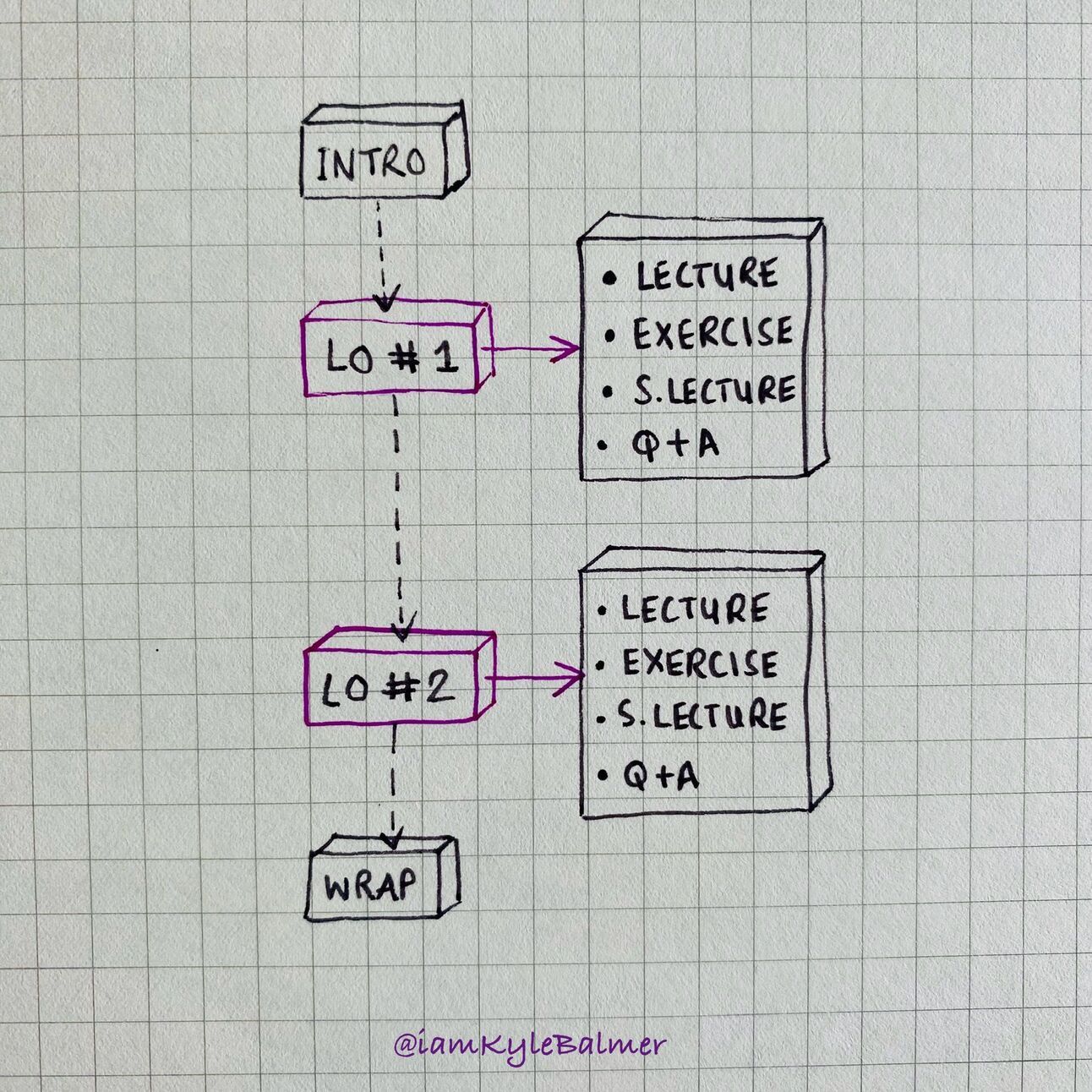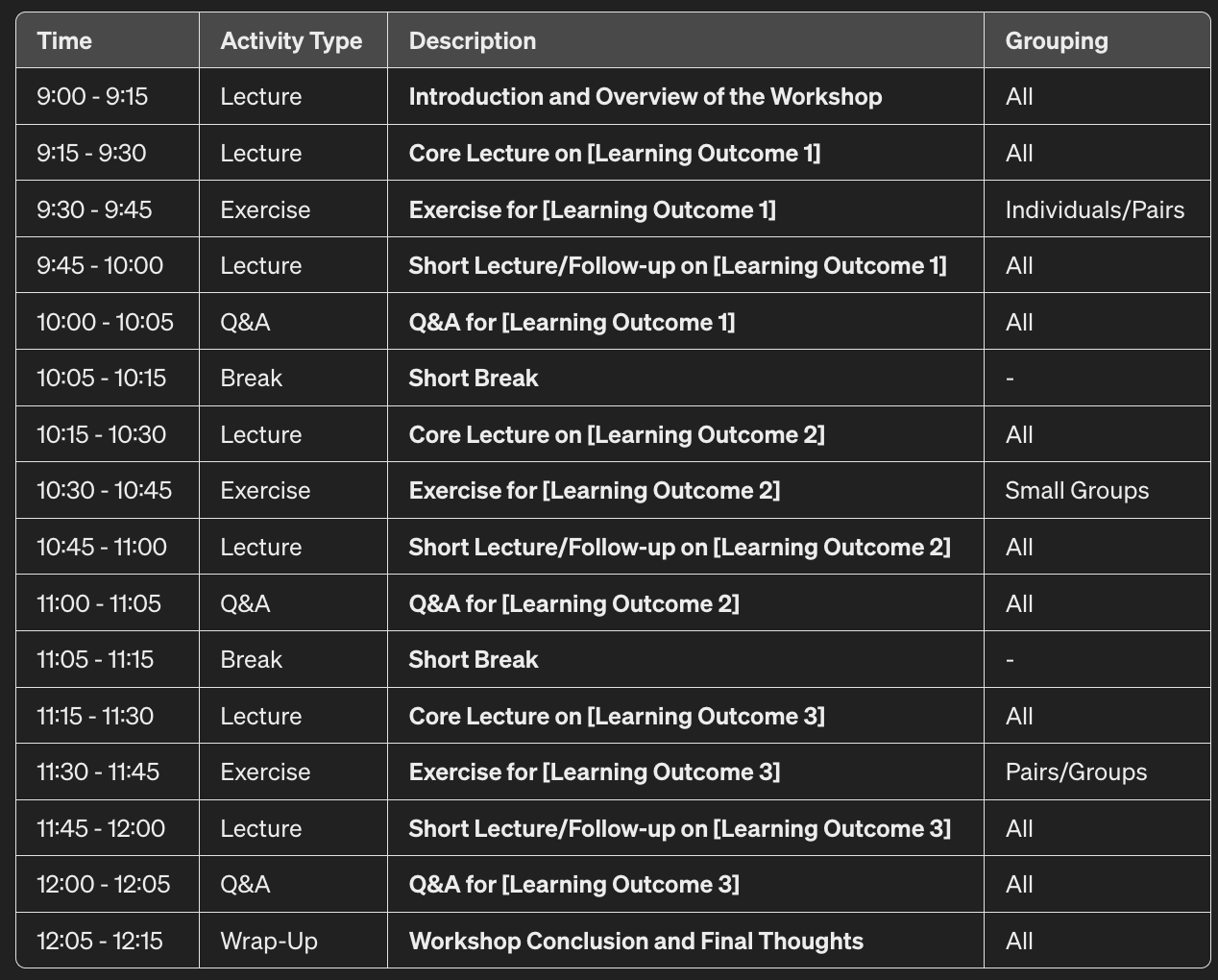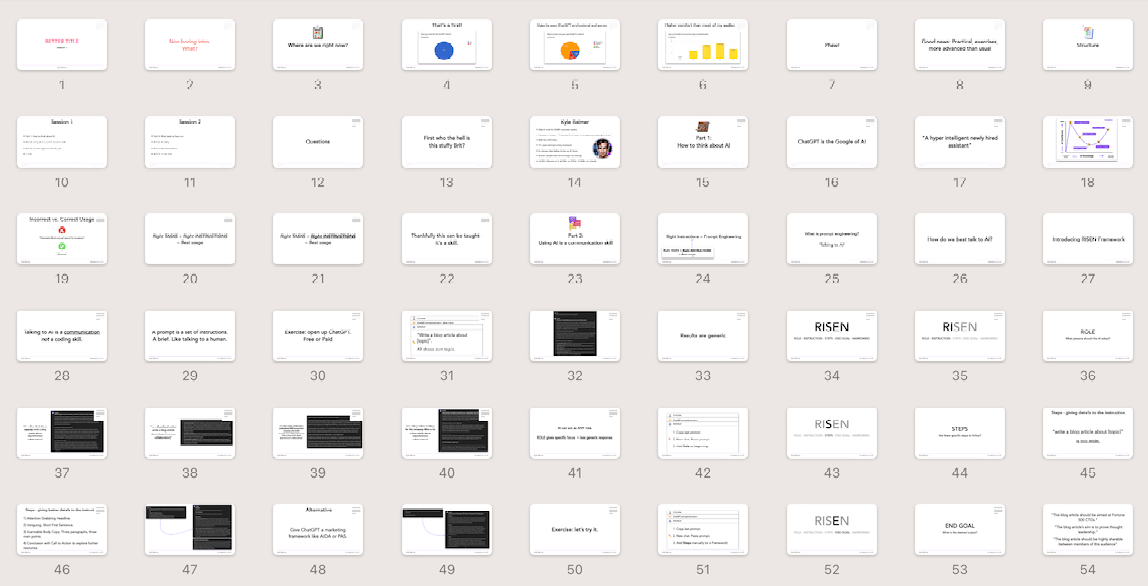Introduction
First things first. If I see even a glint of Powerpoint or Keynote I’m coming for you.
Stop making your workshops (or any presentation) in Powerpoint. It’s the most common method. And the worst. Stop it.
I’ll show you a method that will lead to a leaner, better workshop for your participants.
Let’s get started:
Building your workshops the right way
Building your workshops the right way
- Prepare a skeleton of your workshop
- Alternate lectures and exercises to keep engagement high
- Prepare slides right at the end
We’ll be preparing our workshop as a sketched-out skeleton first.
Focusing on what really matters.
And then, once we have the basic shape in place, we’ll begin to flesh it out and prepare slides.
Many people start working out of their slide making tool for workshops first. The problem here is you’ll start focusing on the details far too early. That’s backwards.
You’ll be worrying about title font size (your problem) rather than how the information will be absorbed (the participant’s problem- and what they care about).
Start with the macrostructure
In the last Part we worked out 2-3 learning outcomes. Ideally no more, especially if your workshop is only 1 hour. 60 minutes is not a long time.
We’ll use these learning outcomes to structure our workshop.
First – we decide the macrostructure.
How long is the workshop? Is there a lunch break? When are coffee breaks?
If your workshop is 1 hour this is all very simple. It’s start, 1 hour delivery, finish.
If your workshop is more than this you’ll need to start structuring in breaks to keep your participant energy high – every 60 minutes or 90 minutes tops.
This is why I recommend starting with a nice simple 1 hour workshop!
It simplifies the process for you massively – as well as being much easier to sell as it doesn’t require your client to carve out half-a-day for the workshop!
Add learning outcomes
Once you know the basic macrostructure we want to slot in the learning outcomes as our main sections.
1 hour session, 3 learning outcomes? 20 minutes each. Give or take. Depending on the complexity.
Longer session? You’ll need to get a bit smarter about the structure. The prompt later in this guide will help you get started with this.
How to achieve each learning outcome

Do not just lecture. This is a workshop. Not a presentation.
You going up there and talking for 1 hour or – god forbid- 3 hours is not going to help your attendees learn.
The power of a workshop is that is allows practice as well as theory. You can teach a little and then get the participants to apply what you’ve just taught.
If your subject is practical this is especially the case. Imagine talking to an audience for 3 hours about welding and not letting them weld anything. It’s ineffective learning.
I generally recommend switching between lecture and exercise every 15 minutes tops. Any more and your lecturing will sap energy from the room.
Here’s the good news for those of you who are scared of public speaking. In a one hour workshop you may only be speaking half the time. I did a 3 hour workshop the other day and was lecturing for less than half that time.
If lecture and exercise are two formats then Q&A is a third. It gives you another switching point to conserve energy and, again, means you don’t have to “memorise” material but can just answer questions as an expert in the field.
Here’s how I’d structure a one hour workshop with 2 learning outcomes:
- Intro 5 minutes (5)
- Lecture Outcome 1, 10 minutes (15)
- Exercise Outcome 1 , 5 minutes (20)
- Lecture Outcome 1, 5 minutes (25)
- Q&A Outcome 1, 5 minutes (30)
- Lecture Outcome 2, 10 minutes (40)
- Exercise Outcome 2 , 5 minutes (45)
- Lecture Outcome 2, 5 minutes (50)
- Q&A Outcome 2, 5 minutes (55)
- Wrap up, 5 minutes (60)
Notice how it uses the same pattern for both learning outcomes:
- Lecture
- Exercise
- Short lecture
- Q&A
Everything is broken up and the format switches often to keep people engaged. That 60 minutes will fly past, believe me.
In each of these sub sections you’ll basically cover the following:
- Lecture – core concept and intro to exercise.
- Exercise – time to complete the exercise.
- Short lecture – reinforcing the core concept via the exercise they did.
- Q&A – getting reflections on exercise and making sure everyone gets the core concept.
If you aren’t comfortable public speaking this is a blessing. What you’ve done is shift the pressure from being all on you to instead being distributed between you and the participants. And this also will make the workshop much more engaging for the participants. Win-win.
What about the exercises?
The exact exercises will depend on your learning outcomes, the level of the participants and the length of the exercise. You can use ChatGPT to help you work out potential exercises by giving it these parameters.
One thing I would say though is that it’s helpful to give a range of exercises:
- individual exercises, short quick applications of knowledge, 1-2 minute exercise.
- pair exercises, when some quick discussion is needed. 3-5 minute exercise.
- small group of 3 or 4. 5-10 minute exercise. When much more in-group discussion is needed.
Basically work out how much you want participants to learn from one another by discussing the topic. If you think their knowledge exchange will be valuable then go with larger groups.
Be aware that it takes time to get people into groups and (importantly) to calm them back down after the exercise. The bigger the groups and the longer the exercise the more time this “exercise admin” takes.
OK! Now that we’ve covered some basic principals let’s put everything into practice with a prompt:
Act as a workshop designer
Help me design a workshop that will be [x] hours long
The learning outcomes are [list learning outcomes, max 3]. Make sure all learning outcomes are covered during the session.
Create a time blocking for my workshop.
No section should be more than 90 minutes. Add breaks every 60-90 minutes.
For each learning outcome there should be a mix of lecture and exercise, ending with 5 minutes of Q&A.
Ideally follow this structure per learning outcome
Core Lecture
Exercise
Short lecture
Q&A
The format (lecture/exercise/q&a) should alternate every 15 minutes minimum to maintain attendee energy.
Suggest exercises for each exercise section. Suggest exercises for individuals, pairs or small groups.
Provide the workshop outline with timings in a table. Make sure than the sum of all sections adds up to the total length of the workshop. Give ChatGPT your learning outcomes and length of the workshop and this prompt will compile a basic skeleton outline of the workshop.

Provide your actual learning outcomes and ChatGPT will suggest topics and exercises for you.
Remember, this should be a jumping off point only. A basic skeleton that you are now going to fill in yourself based on your own expert knowledge and what we discussed above.
The slides
Once you’ve got your skeleton in place you can finally create your slides!
I’ll allow it!
Start literally with one slide per section:
- Intro
- Learning Outcome 1
- Learning Outcome 1 Exercise
- Learning Outcome 1 Q&A
- Learning Outcome 2
- Learning Outcome 2 Exercise 2
- etc.
Basically recreate your skeleton in slides. Then start to fill in extra slides if you need them. There isn’t time to go into workshop slide design here but generally:
- limited text – one sentence per slide
- images only when instructive, not for decoration
- always cut rather than add slides

Example of my recent deck: limited text, images when instructive and less not more.
What we most need to avoid is you using the slides as a crutch. The worst workshops are when the presenter reads off the slides. Ideally you aren’t even looking at them yourself -we’ll discuss this in the final Part when we discuss delivery.
For now you have the core steps to develop your workshop though. In the next Part we’ll talk about securing clients for your brand new workshop.